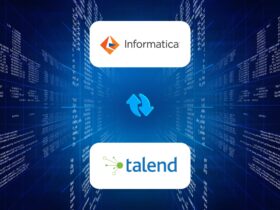ELT using Talend
Everything is data-driven in today’s market and loading a data warehouse can be extremely time-consuming. The process of extracting, loading and transforming (ELT) data, streamlines the tasks of modern data warehousing and managing big data so that businesses can focus mainly on data mining and actionable insights. Extract/Load/Transform (ELT) is the process of extracting data from one or multiple sources and loading in into a target data warehouse. The transformation component is pushed to the target database and this helps in improving the performance. This is greatly helpful for processing massive data sets required for business intelligence (BI) and big data analytics. ELT is an alternative and improvised approach to Extract/Tr ansform/Load (ETL). ELT reduces the time data spends in transit and boosts efficiency.
ansform/Load (ETL). ELT reduces the time data spends in transit and boosts efficiency.
Let us explore what Talend has to offer an as ELT tool.
Talend is an ELT tool used for Data Integration. Software solutions like data preparation, data quality, data integration, application integration, data management and big data are provided by the tool. Talend is a collection of all the products for the services mentioned above. Among the various products that Talend offers, these are a few: Talend Data Quality, Talend Data Integration, Talend Data Preparation, Talend Cloud, Talend Big Data, Talend Master Data Management (MDM), Talend Data Services Platform, Talend Metadata Manager, Talend Data Fabric, Talend Platforms, Talend Enterprise and Talend Open Studio.
In order to draw efficient decisions, an organization needs to assemble the data from all or required data sources. Not just assembling, the data needs to be unified in a convenient way, in a format that aids in quicker analysis. This process of Data Integration calls for the need of tools like Talend. Talend is one of the leading tools in the industry to provide real-time decisions that are more data driven. It has a huge capacity of processing 1 TB of data in real-time, 1000 data integration jobs are executed, and the data warehouse is updated every 5 minutes. All this leads to the quicker analysis of the trend from the customer data.
Few of the efficient features that Talend provides are:
- Enables faster development and deployment as majority of the tasks are automated.
- The products of Talend are open sourced, which makes it budget friendly.
- All the products under one roof makes it a go-to solution for the entire needs of the organization.
- The built-in connectors, features for data integration and synchronization, automatically converting jobs to Java code makes it more reliable.
- Connections can be established across multiple data sources like RDBMS, SaaS, and also with systems like SAP, CRM and Dropbox.
- The Talend Open Studio is one of the best ELT tools used for data integration. It is a developer tool that allows one to drag and drop components to create and run jobs.
- Talend also provides real time statistics while analyzing the data and thus more accurate and quick results can be obtained.
- Faster designing, efficient management, easy scalability, early cleansing, better collaboration, Agile Integration are few of the other key features to prefer Talend as an ELT tool.
How Talend works as a Data Integration tool
An organization’s raw data is extracted from numerous sources and stored in a data warehouse using Talend integration platform. Real time data is being handled by OLTP (Online Transactional Processing) system on any database. The Talend Integration platform replicates the data from OLTP system to data warehouse systems. Thus, Talend helps in integrating data from various systems and move them into data warehouses. All this is done with real-time data and around 1000 integration jobs are executed daily.
Data tools are in plenty in the market and the competition is very fierce. The ELT tools worth mentioning among the lot, apart from Talend, include Hevo Data, Luigi, Blendo, Matillion, StreamSets, Etleap, Airflow, Kafka, Nifi etc.
As compared to other ELT tools, Talend stands out with the following features:
- Talend as a tool is available in both open source and commercial editions.
- As mentioned above, Talend has its open source edition and can be downloaded for free, which makes it the most preferred tool for companies with lower budgets.
- Since Talend is developed on java code, it can be run on any platform that supports Java. Talend also supports custom code.
- Deployment is a cake walk using Talend, while other tools demand advanced automation during deployment.
- Talend supports parallelism and scheduling, only with the commercial edition.
- One single job run can move millions of reports without much ado.
#RandomTrees #ELTTools #Talend







